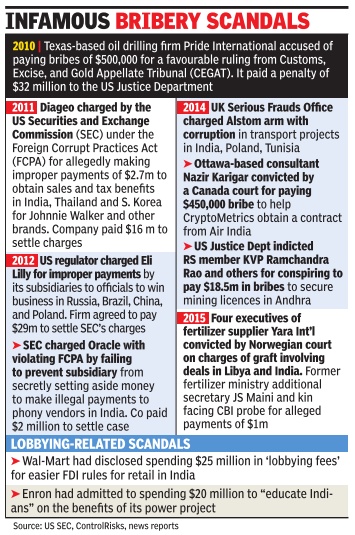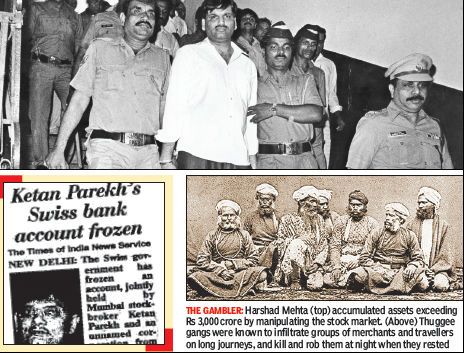Crime: confidence tricksters, cheats, criminals

This is a newspaper article selected for the excellence of its content. |
The great Indian chor bazaar
TNN | Apr 25, 2013, 09.56 PM IST
King Cons | India has had its share of con men — from the notorious Thuggees to Harshad Mehta. Here's how TOI covered them.
In capturing the India story, The Times of India has, over the last 175 years, been just as diligent at recording the activities of crooks, criminals and the agencies set up to rein them in as it has been at documenting the lives of the great and the distinguished.
Contents |
Thuggee
Four months after its launch, on March 16, 1839, a paper, then British-owned and called The Bombay Times and Journal of Commerce (later converted into The Times of India), carried a report on how the Thuggees, a secret cult which had then spread terror across India by strangling people, were finally getting the punishment they deserved: 13 of them had been given the death penalty, 70 sentenced to transportation for life, and 25 had been given life imprisonment. Thuggee gangs were known to work with military precision, infiltrating groups of merchants and travellers on long journeys, and killing and robbing them at night when they rested. In 1822, the then Governor General Lord William Bentinck appointed an officer in the Bengal Army, William Sleeman, to rid India of the secret cult.
Even after Thuggees had been almost stamped out by the 1840s, the paper warned that treating them on a par with other criminals, especially British ones, would be a grievous error. The paper drew a clear distinction between an English thief and a Thug, who killed people as a sacrifice to goddess Kali. The paper noted:
"The English thief knows that his conduct is criminal, both in the sight of heaven and his fellow men... But the Thug believes in his very heart, that murder is not sinful. He is commanded by divinity to rob and kill." 'WORSHIP OF MURDER'
On March 8, 1851, the paper, comparing Thuggees with criminals in Britain, said: "The only methods to be employed [to get rid of the Thuggee menace] are imprisonment for life, or extermination to the last man, and in the spirit of charity and genuine wisdom, the government has adopted the former mode of repressing the frightful iniquity of Thuggism. Its votaries believe that whilst a single Thug remains at large, the worship of murder is only in abeyance for a season, but if a new generation grow up, whose fathers have never practised the dreadful trade, they will view it with the same abhorrence as the rest of mankind. If a similar result could be fairly counted upon in case of house-breakers at home, would not society willingly consent to feed and clothe them, if need be?"
William Sleeman, who wiped out the Thuggees.
Criminal Intelligence Department (CID)
THE CID SAGA | We know of the CID today as one of the key arms of police investigation, but it was the action against the Thuggees that, in a way, led to its creation. The Thuggee and Dacoity Department, formed by Sleeman as a dedicated police force, was renamed the Central Criminal Intelligence Department (CID) in 1904. The TOI reported on May 14 that year that H A Stuart had been appointed its first director.
Life Insurance Corporation of India (LIC)/ Haridas Mundhra
TOI continued its focus on crime post-Independence with comprehensive coverage of the 'Mundhra affair,' free India's first major scam. The scam broke in September 1957 with questions raised in Parliament about investments made by the state-owned Life Insurance Corporation of India (LIC) in a private firm in Kanpur owned by industrialist Haridas Mundhra. TOI reported in detail on the scam, tracking the proceedings of the Chagla Commission probing the matter and depositions before the panel, and it wrote of how the then finance minister T T Krishnamachari had to quit as a result. Its headline on Feb 14, 1958 — 'Mundhra deal was a dictated transaction: Chagla report on LIC investments' — laid bare the truth that the Mundhra shares had been bought to boost their price above market value.
From TOI archives (Jan 21 | 1958)
The series of transactions which ended in LIC investing Rs 1,38,85,750 in six Mundhra concerns were subjected to a close scrutiny when the one-man commission began its inquiry with a deposition by Mr Feroze Gandhi, MP.
Harshad Mehta, Ketan Parekh
Later, in 1992-93, TOI played a key role in exposing con man Harshad Mehta and his stock market scam. The paper reported Mehta's journey from the time he was photographed next to his Toyota Lexus, until his death in 2001, and through investigative stories revealed how he'd rigged prices and manipulated the markets. When Ketan Parekh followed in Mehta's footsteps 1999 to 2001, TOI in a telling headline described him as "Harshad Mehta minus the flourish" and reported how, before he was debarred from trading in Indian stock exchanges, he had accumulated assets in excess of Rs 3,000 crore.
TOI, on March 11, 2001, did a comparison of the two men accused of stock market manipulation since the 1990s: Harshad Mehta and Ketan Parekh. In that piece, the paper wrote of how Mehta, coming from a humble background, rose from being a nondescript insurance clerk in the 1980s to the most notorious player in the stock market. Parekh, a chartered accountant, on the other hand, came from a rich family of brokers and was related to many big brokers in the Bombay Stock Exchange. But while Parekh was publicity-shy, Mehta, at one time, had been publicity-savvy; later, as he was booked in many cases, he developed a 'cultivated' silence.
From TOI archives (March 11 | 2001)
Both are Big Bulls. Post-1992, Harshad Mehta became the ex-Big Bull. Mehta's every move was watched by the market. Now, his every move is watched by intelligence agencies. Parekh, also known as the Pentafour Bull or simply 'KP' is the current mover and shaker of the Bombay Stock Exchange (BSE). Every broker wants to know what is on the 'K Index'.
Natwarlal
An individual con man, though, soon put Mundhra in the shade and drew the attention of all of India. His name, Natwarlal, became a byword for cheating. A native of Bihar, he became known for forging the President's signature and selling the Taj Mahal and the Red Fort to gullible foreigners. TOI reported, over the years, his numerous arrests, his conviction in over 100 cases, and, in a review of his over-50-year-long crime career on July 1, 1991, called him "a Wodehousian criminal" who could "make crime sound like sheer sport or at least a shamelessly light-hearted way of earning one's livelihood."
On April 23, 2011, The Times of India's Crest edition, while doing a piece on Natwarlal's native village in Bihar's Siwan district, wrote of how the con man had duped people even in death. Natwarlal was last seen in 1996, at the New Delhi railway station as he was being taken from Kanpur to Delhi for treatment at AIIMS. He conned the accompanying policemen and disappeared into the crowd. He was 84 years old then. His lawyer, Nandlal Jaiswal, said Natwarlal died in 2009 at the age of 97. But the con man's younger brother G P Srivastava claimed to have cremated him in 1996. No one knows which story is true.
Policemen as criminals
500 city cops held in past 3 yrs for crimes Minister Tells Parliament; Corruption Tops Chart Dwaipayan Ghosh | TNN 2010
New Delhi: Delhi Police may claim to be a ‘‘clean force’’ but figures tell a different story. Replying to a question in Parliament, the minister of state in the ministry of home affairs (MHA), Mullappallay Ramachandran, on Tuesday said 500 officers of Delhi Police had been arrested for various crimes in the past three years.
Though the minister claimed number of crimes committed by police personnel is not rising, he refused to provide details of action taken by the g ove r n m e n t against tainted cops. ‘‘The data is still being collected,’’ he said.
According to the written reply, a copy of which is with Times City, 116 police personnel were arrested in 2007. This number saw a huge 54% rise in 2008, with 251 personnel being arrested for various crimes. In 2009, 133 tainted cops were arrested.
A large number of policemen were arrested on graft charges. In 2007, a total of 51 personnel were arrested for being involved in corruption, while another 124 were arrested on similar charges in 2008. Last year, 30 policemen were arrested after they were found involved in corruption. However, the more disturbing news was that of these, 12 were middle-level officers holding ranks of ACP and inspector.
The data reveals at least six personnel were found to be involved in murder or attempt to murder cases in 2008. Four others were found involved in the same offence in 2009. This includes six constables, three head constables and one assistant sub-inspector. Another 30 personnel, including 21 constables, were found to be involved in various cheating cases in
the past three years. It is often alleged that beat officers are involved in extortion cases. At least 16 cops, including two inspectors, have been found to have involved in extortion in the last three years. Six others, including two sub-inspectors, have been booked for rape charges. Senior police officers admitted there might be some more tainted cops inside the force. ‘‘There are several others who are under temporary suspension or undergoing internal enquiries on various charges levelled against them. It is therefore, not surprising if these numbers see a significant rise in the coming days,’’ said an officer at the vigilance wing.
The police claimed they have adopted a ‘‘zero-tolerance’’ towards corruption and other crimes. ‘‘The numbers provided by MHA prove that we are not trying to hush up crimes,’’ claimed a senior officer at the police headquarters.

